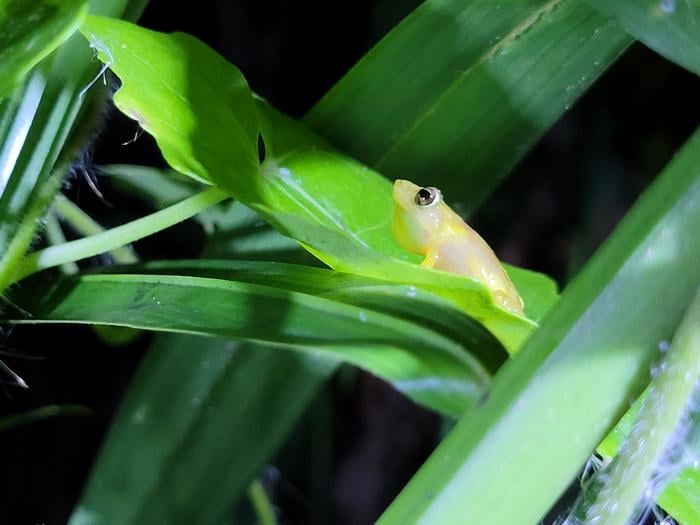Researchers have applied modern portfolio theory, typically used in financial investments, to develop conservation strategies for the endangered coquí llanero frog in Puerto Rico.
Summary: A study suggests that economic investment principles could guide conservation efforts for Puerto Rico’s rarest frog species, offering a new approach to wildlife protection under climate uncertainty.
Estimated reading time: 6 minutes
In an unexpected intersection of economics and ecology, researchers have found that a common financial investment strategy could be the key to saving one of Puerto Rico’s most endangered species. A new study published in Frontiers in Conservation Science demonstrates how modern portfolio theory, typically used to balance risk and reward in financial markets, can be applied to protect the coquí llanero, Puerto Rico’s smallest and possibly most endangered frog species.
The coquí frogs, known for their distinctive high-pitched chirp, are unofficial mascots of Puerto Rico. However, the coquí llanero faces a precarious future, with its entire population confined to just three small freshwater wetlands on the island’s northern coast. This limited habitat leaves the species highly vulnerable to climate change impacts, including major storms and rising sea levels.
Applying Financial Wisdom to Frog Conservation
Mitch Eaton, lead author of the study and research ecologist for the Southeast Climate Adaptation Science Center, explains the frog’s predicament: “There’s only so much the coquí can do on their own to avoid climate risks. So, it’s important that we think about how to manage and mitigate risk within this complex ecosystem.”
The research team’s novel approach applies modern portfolio theory to conservation efforts. In finance, this theory suggests that the most stable investment portfolio combines assets that respond differently to changing market conditions. For wildlife conservation, this translates to diversifying conservation strategies to mitigate risks from an uncertain climate future.
“Diversification of investments is kind of a magic bullet for stability under future market uncertainty,” says Eaton. “The idea behind using modern portfolio theory is to manage risk under future climate uncertainty, and to help managers consider investments more carefully with realistic variables like budget constraints.”
Modeling Conservation Strategies
The researchers created models incorporating various factors:
- Currently protected habitats
- Future sea-level rise scenarios
- Future precipitation and temperature projections
- Range of potential funding levels
Using these models, they developed two portfolio analyses:
- A strategy maximizing conservation benefits within budget constraints
- A strategy balancing potential benefits against lowering extinction risk, also subject to funding limits
The benefit maximization strategy favored relocating frogs to already protected areas to minimize costs. In contrast, the risk-benefit tradeoff strategy prioritized higher-cost investments in new land parcels for frog relocation, resulting in a lower extinction risk.
Importantly, the study found that relying solely on existing protected areas may not sufficiently mitigate future climate risks. Investing in additional habitats, despite higher costs, could be crucial for the species’ survival.
Unexpected Findings and Implications
One surprising outcome of the research was the identification of potential frog habitats on Puerto Rico’s eastern side. This discovery could significantly expand options for protecting the coquí llanero by increasing its geographic range beyond the northern coast.
While the study focused on a single species, the researchers believe this approach has broader applications. Modern portfolio theory could potentially be adapted for various species and resource management needs in uncertain future scenarios.
Challenges and Limitations
The researchers acknowledge two main limitations of their current approach:
- The model only considers one species when assessing competing conservation actions.
- Applying high-cost investments in real-world scenarios requires more detailed consideration of local conditions, such as specific parcel conservation or restoration costs.
Despite these constraints, the study demonstrates the potential of interdisciplinary approaches in tackling complex conservation challenges.
The Future of Conservation
As climate change continues to threaten biodiversity worldwide, innovative approaches like this could provide valuable tools for conservation managers. By borrowing strategies from the financial world, ecologists and wildlife managers may be better equipped to make difficult decisions about resource allocation and risk management in an uncertain future.
The application of modern portfolio theory to wildlife conservation represents a shift in thinking about species protection. It encourages a more holistic, long-term view of conservation efforts, considering not just immediate threats but also future scenarios and their associated risks.
As we face increasingly complex environmental challenges, cross-disciplinary approaches like this may become essential in our efforts to protect vulnerable species and ecosystems.
Quiz
- What is the name of the endangered frog species discussed in the article?
- How many locations currently house the entire population of this frog species?
- What economic theory did researchers apply to conservation efforts in this study?
Answer Key:
- The coquí llanero frog
- Three small freshwater wetlands on Puerto Rico’s northern coast
- Modern portfolio theory
Further Reading:
Glossary of Terms:
- Coquí: A group of small tree frogs native to Puerto Rico, known for their distinctive call.
- Modern Portfolio Theory: An investment strategy that aims to maximize returns for a given level of risk through diversification.
- Sea-level Rise: The increase in the level of the world’s oceans due to global warming.
- Biodiversity: The variety of plant and animal life in a particular habitat or ecosystem.
- Climate Change: Long-term shifts in temperature and weather patterns, primarily driven by human activities.
- Conservation: The protection, preservation, and careful management of natural resources and the environment.
Enjoy this story? Get our newsletter! https://scienceblog.substack.com/
If our reporting has informed or inspired you, please consider making a donation. Every contribution, no matter the size, empowers us to continue delivering accurate, engaging, and trustworthy science and medical news. Independent journalism requires time, effort, and resources—your support ensures we can keep uncovering the stories that matter most to you.
Join us in making knowledge accessible and impactful. Thank you for standing with us!

